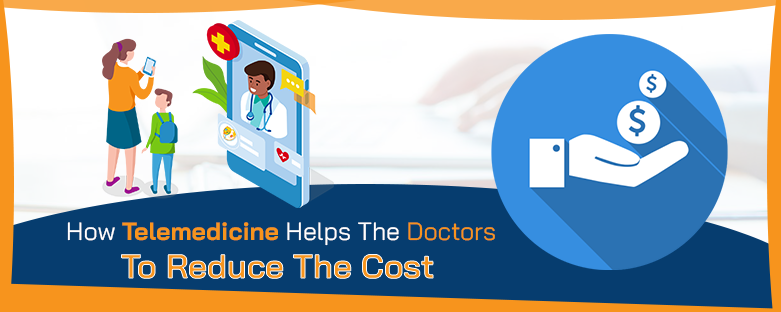How Telehealth Helps The Doctors to Reduce The Cost
The rising healthcare costs have been a growing concern for doctors and patients alike. With increasing overhead expenses, administrative burdens, and the need for transportation, healthcare costs can quickly increase, putting a strain on medical practices and patients’ budgets. However, telehealth has emerged as a solution that can help doctors reduce costs and improve patient care.
Telemedicine, or telehealth, refers to using telecommunications technology to deliver medical services remotely. Through virtual consultations, remote patient monitoring, and other telehealth tools, doctors can provide medical care without needing in-person visits. This has significant cost-saving implications for doctors and potential benefits for patients in terms of improved access to care and reduced healthcare expenses.
In this blog, we will explore how telehealth can help doctors reduce costs in their practice. We will dive into various aspects of telehealth, including streamlining patient consultations, reducing overhead expenses, eliminating transportation costs, minimizing administrative burdens, optimizing time and resources, and ultimately lowering healthcare costs.
By understanding the financial advantages of telemedicine, doctors can harness its potential to provide quality care to their patients and make their practice more cost-effective and efficient. Let’s dive into how telehealth can be a game-changer for doctors in reducing healthcare costs.
Use of Remote Analysis Services
Remote analysis services for instance telepathology and teleradiology allow the pooling of resources, resulting in lower costs and better quality treatment. Via telemedicine, smaller facilities that don’t have enough volume can share resources to provide coverage around the clock at a lower cost. Radiology facilities are very costly in the US. Yet telemedicine will translate into healthcare system cost savings. For high-quality radiology research at a cheaper price, medical images such as X-Rays, MRIs, or CT scans can be safely transported to offshore locations.
mHealth Monitoring Technologies
The use of mHealth tracking technology reduces the cost of chronic disease complications. For example, a rise in body weight due to fluid retention is also an indication that, due to heart disease, someone will soon need to be hospitalized. Disease managers with access to information on regular weight could be able to help a person with fluid retention get the treatment they need before a crisis happens. Averting emergencies increases the quality of treatment and reduces costs.
Compliance With Appointments
Patients missing their appointments will cost physicians time and money and interrupt their schedule’s smooth flow. It may also result in non-compliance, especially with treatment regimens, appointments, and follow-ups, which may be a health hazard for patients.
“The Doctors Firm, according to surveys conducted by medical malpractice insurer,” the most common risk management problems included failure to contact patients after their missed appointments and a shortage of monitoring facilities to ensure sufficient follow-up treatment. Virtual appointments minimize these risks because registered patients may be contacted to follow up on their missed appointments, if any, eliminating unnecessary expenses in the future.
Telehealth will assist workers in keeping up with doctor’s appointments from home security and without taking off work.
Usually, seeing the doctor for 20 minutes takes 2 hours as you take into account travel time and time at the treatment centre and with the doctor. And the use of telehealth facilities helps ensure that your workers get the treatment they need from their own home’s protection.
Cuts Expenses for Patients
Our patients are wasting a lot of cash and time looking for healthcare. With a telehealth visit, on their phone, laptop, or another digital computer, the doctor comes to the patient. Imagine how the expenses will accumulate for travel, parking, childcare, and taking time off work. It can be stressful to fly to a remote doctor’s facility with the extra effort it takes, but it is the costs that can really add up. Patients have to fly overnight in some rural regions to meet specialists in more populated regions. By introducing a telemedicine network, Oregon Health and Science University saved their patients $6.4 million per year in travel costs. One UPMC patient survey found that 40 per cent of their patients said they would miss care because of the strain of unnecessary travel to their facilities if they did not have access to a virtual visit.
Patient Demand
Telemedicine is what consumers want. Telemedicine’s greatest impact is on the patient, their family, and their community. The use of telemedicine technology decreases the patient’s travel time and associated pressures. Study after study has reported patient fulfilment and support for telehealth services over the past 15 years. These programs give patients access to providers that may not otherwise be available, as well as medical services that do not entail long-distance travel.
Improves Conventional Face-To-Face Medicine
The basis for high-quality patient care and reducing health care costs is a good physician-patient relationship. Telemedicine should complement, not substitute, the delivery of conventional treatment. With telemedicine care services, patient in-person care will continue to be taken care of while also having the versatility and comfort of remotely seeing patients for follow-up appointments, check-ups, and education when needed or necessary.
No travel Time for Patients
89 per cent of rural patients have to drive 8 km to reach some kind of health care, based on a recent survey. A tertiary consultation requires 700 million people living in rural India to travel a distance of 75 to 100 km. Research has shown that the use of telemedicine will eliminate between 33 per cent and 50 per cent of patient transfers. In terms of transfer costs saved by deploying telemedicine, a U.S. study reported cost savings of $500,000. This strategy is successful in lowering the burden of healthcare costs, as well as in reducing the discomfort to the families of patients substantially.
Conclusion
In conclusion, telehealth offers a cost-effective solution for doctors to reduce expenses in their practice while maintaining high-quality patient care. By eliminating the need for in-person visits, lowering overhead expenses, minimizing administrative burden, and eliminating transportation costs, telehealth reduces costs for doctors. By utilizing telecommunications technology, doctors can streamline consultations, optimize resources, and deliver cost-effective care.
Embracing telemedicine has the potential to transform the healthcare landscape, making it more accessible, affordable, and efficient. It’s time for doctors to explore and integrate telemedicine into their practice to achieve cost savings and enhance the overall healthcare experience for their patients.





It can benefit doctors by increasing the patient number with quality treatment and reducing the long line in hospitals. It can help to stop the spread of any kind of virus.
Telemedicine can help doctors to reduce costs along with fast treatment. Using this technology, doctors can treat patients from anywhere at any time. Impressive post. I liked this post!
Telemedicine platforms can reduce doctors’ costs and help those who need emergency care and can not reach a hospital or any doctor. Thanks for sharing this informative post with us.
Patients missing their appointments will cost physicians time and money and interrupt their schedule’s smooth flow. I like the post. Thanks for sharing.